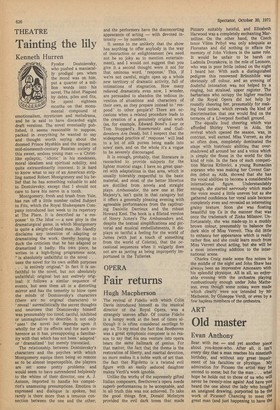Old master
Evan Anthony
Bear with me — and yet another piece about you-know-who. After all, it isn't every day that a man reaches his ninetieth birthday, and without any great impairment of his faculties or physique. MY admiration for Picasso the artist may be second to some; but for the man . what hope he holds out to those of us who will never be twenty-nine again! And have yoLl heard the one about the lady who bought an unsigned drawing, purported to be the work of Picasso? Chancing to meet the great man (and just happening to have the
drawing with her), and with all the temerity of one fresh from the triumph of the January sales, she asked him if the drawing were actually one of his. With a flourish the amiable fellow (who has immortalized tableclothes) signed the Picture, proclaiming, " It is, now!"
There must be a moral (or perhaps an Immoral) in that story, and should you have somehow managed to escape the searching analyses of TV and the Sunday magazines, and now regret your Indifference, cheer up — all is not lost. The ICA has mounted a mini-retrospective, described as an 'intimate homage ' Wherein collectors in London are showing drawings and paintings dating as far back as 1895. One doesn't review a Picasso exhibition: it is merely mentioned; it is there.
Also there, on exhibition at Roland, Browse & Delbanco, Cork Street, is the Work of another virtuoso, Paul Klee. The sixty water colours lent by Felix Klee, Pictures by his father, are well worth your time. Arranged chronologically, it's a show that accomplishes the not inconsiderable feat of clearly tracing the development of a prolific genius. Within the body of work Of Paul Klee one can see the embryo of Many a modern experiment and of many a current avant-garde trick. But Klee's imagination and originality are strongly supported by technical skill and unerring sensitivity. Where so much of what is Produced today is art school exercise stuff elevated to an importance greater than either extrinsic or intrinsic consideration warrants, Klee's experiments contain a richness that is both intellectual and aesthetic. Just as doctors are obliged to study the skeletal structure, art students should be encouraged to pore over Klee. As well as being instructive, he is inspirational.
Among lesser deities, British ' naive ' painter James Lloyd, at Grafton Street's Portal Gallery, impresses as being not all that naive. Life began at forty for Lloyd as a painter, and now, some twenty-six years later, he has established a reputation as one of the major primitives. The distortions of his drawing make his farm scenes look somewhat surrealistic; a foreshortened arm can look like a deformity. But then the remarkably detailed brush work distracts you and you begin to wonder about things like how many hours per square inch does it take him. Lloyd is a pointillist — a nice thing to see in an age when air brushes and benday strips seem to have taken over.
I always feel guilty when I fall for such pretty pictures as those painted by Alfred Rozelaar Green, on show at the John Whibley Gallery, Cork Street. Green was born in London, of Anglo-Dutch parents, and now lives and works in Paris. The scenes of boulevards and parks and cafes look like reflections in water, and perhaps a gallery full of them does point out a tendency to wear out a single idea — but it's not a bad idea and if Roy Jenkins can like Tretchikoff . . .



































 Previous page
Previous page